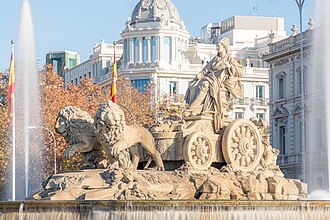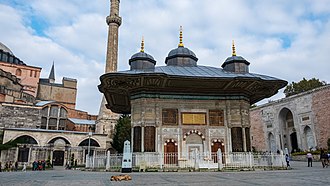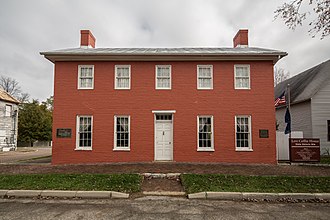Discover Your Roots
SIGN UPDiscover Your Roots
SIGN UPFountain is an English gender-neutral name derived from the Latin "fons" (genitive "fontis"), meaning source or spring. The name carries the meaning of "A Spring". Fountains have been historically significant, originally serving as functional water sources for drinking, bathing, and washing in ancient civilizations. They were also used for decorative and celebratory purposes. In modern times, fountains are primarily used for decoration, entertainment, and to honor individuals or events. The name Fountain symbolizes purity, life, and the power of nature. It evokes the imagery of water, vitality, and the artistic and architectural significance of fountains throughout history.

The Fountain of Neptune in Florence, Italy, also known as Fontana del Nettuno, is located in the Piazza della Signoria, in front of the Palazzo Vecchio. Commissioned by Cosimo I de' Medici in 1559 to celebrate the marriage of Francesco de' Medici I and Grand Duchess Joanna of Austria, the fountain was designed by Baccio Bandinelli and created by Bartolomeo Ammannati with the assistance of several other artists between 1560 and 1574. It incorporates mythological figures and iconographies that symbolize both Cosimo I de' Medici's power and the union of Francesco and Joanna. The fountain underwent a major restoration completed in 2019, restoring it to its original glory. Cosimo I de' Medici, Duke of Florence from 1537-1569, played a significant role in shaping Florence's art and architecture during his reign, earning comparisons to Augustus and positioning himself as the architect of the new age of Florence. The Fountain of Neptune stands as a testament to the artistic and architectural contributions of Cosimo I de' Medici, showcasing his influence on the city's historical landscape.

The Fountain of Cybele, also known as Fuente de Cibeles or La Cibeles, is a neoclassical fountain located in the heart of Plaza de Cibeles in Madrid, Spain. The centerpiece of the fountain depicts Cybele, an ancient Phrygian earth and fertility deity, riding a chariot pulled by two lions. This iconic sculpture, designed by Ventura Rodríguez and crafted by Francisco Gutiérrez and Roberto Michel, has become a symbol of the city. Originally constructed in 1780, the fountain was later relocated and reoriented in 1895. With a maximum water capacity of 278 m3, it has served as a gathering place for both Real Madrid's supporters and players to celebrate victories and as a site for the Spain national football team's successes. The Fountain of Cybele also holds a replica in Mexico City, inaugurated in 1980. Despite experiencing damage to the goddess sculpture on two separate occasions, it continues to stand as a significant cultural and historical landmark in Madrid.References:- Fraguas, Rafael (24 May 2014). "Las deidades del balompié". El País.- López de Azcona, María Concepción; Fort González, Rafael; Mingarro Martín, Francisco (2002). "La conservación de los materiales pétreos en la Fuente de Cibeles, Madrid (España)". Materiales de Construcción.

Fountain Hughes (c. 1859 – July 4, 1957) was an American former slave who gained freedom in 1865 after the American Civil War. He was born in Charlottesville, Virginia, and spent most of his life working as a laborer. In 1881, he moved to Baltimore, Maryland. Hughes' interview with the Library of Congress in June 1949, conducted as part of the Federal Writers' Project, provides a valuable oral history of former slaves. He was the grandson of Wormley Hughes, who was enslaved by President Thomas Jefferson. Despite informal freedom granted to Wormley Hughes, his wife Ursula and their children were sold in 1827, leading to a heartbreaking separation. Hughes' childhood was marked by deprivation and hardships, including being barefoot and wearing dresses until a certain age. After gaining freedom, he worked for a meager wage. In 1881, he relocated to Baltimore and worked as a manure hauler. His interview also shed light on societal changes he witnessed, expressing a preference for freedom over slavery. Hughes passed away in 1957.There is some discrepancy regarding his claimed age, with census records suggesting different birth years. Hughes' story provides a poignant insight into the harsh realities of slavery and the resilience of those who endured it. His interview is available online through the Library of Congress and the World Digital Library, preserving his valuable account for future generations.

The Fountain of Sultan Ahmed III, also known as III. Ahmet Çeşmesi, is an impressive sebil located in the prominent square in front of the Imperial Gate of Topkapı Palace in Istanbul, Turkey. This fountain, built during the Tulip period in 1728 under the patronage of Sultan Ahmed III, served as a social hub and gathering place during the Ottoman era in Constantinople. The architecture of the fountain is striking, featuring a large square block with five small domes and mihrab-shaped niches adorned with foliate and floral designs, each containing a drinking fountain. The water supply comes from an octagonal pool inside the kiosk, and there are calligraphic plates with poetic verses dedicated to water and its donor by Seyyid Hüseyin Vehbi bin Ahmed. The Fountain of Sultan Ahmed III is a significant historical and architectural landmark, representing the artistic and cultural richness of its era. It is a must-see attraction for visitors to Istanbul, offering a glimpse into the city's rich heritage.

Fountain City, formerly known as Newport, is a town located in New Garden Township, Wayne County, Indiana, with a population of 714 as of the 2020 census. Originally named New Garden in 1818, the town was later renamed Newport in 1834 and finally received its current name, Fountain City, in 1878 due to its natural springs. The town is renowned for the historic Levi Coffin House, a crucial station on the Underground Railroad, which is now an Indiana State Historic Site.According to the 2010 census, Fountain City covers a total area of 0.26 square miles and had a population of 796 people. The racial makeup of the town was 97.2% White, 0.9% African American, and 0.1% Asian. In the same census, it was reported that 39.5% of households had children under 18 living with them, and the median age of residents was 37.6 years.Notable individuals associated with Fountain City include Levi Coffin, a prominent abolitionist and conductor of the Underground Railroad, Charles Conner, a renowned painter, William Penn Nixon, a distinguished publisher and politician, and Stephen Venard, a notable lawman.Fountain City is a town with a rich history and notable figures, making it a significant part of Indiana's cultural heritage.
All images displayed on this page are sourced from Wikipedia or Wikimedia Commons.We use these images under their respective Creative Commons or public domain licenses. Wherever applicable, author attributions and license information are provided. If you believe an image is used incorrectly or outside its license terms, please contact us so that we can review and correct the issue.